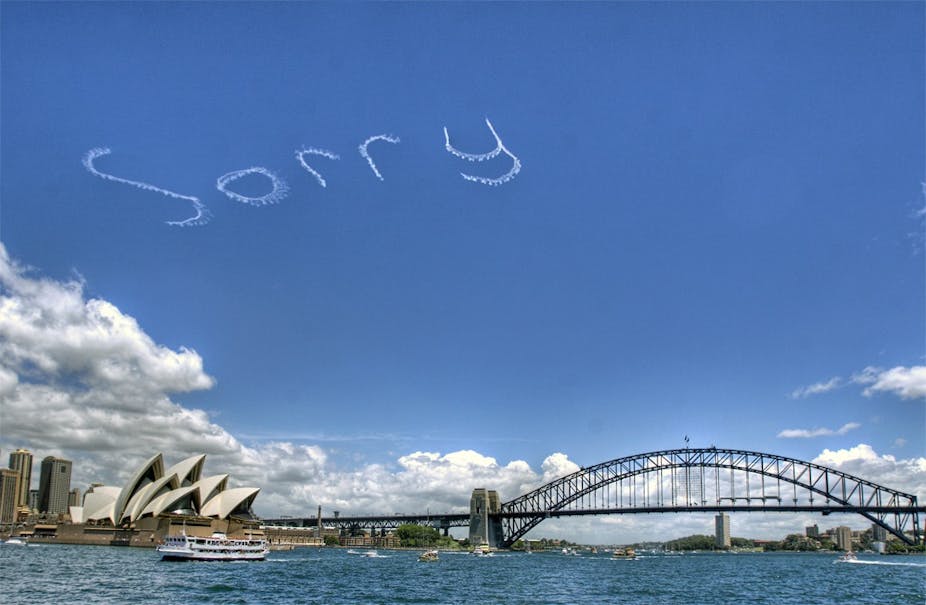The time has now come for the nation to turn a new page in Australia’s history by righting the wrongs of the past and so moving forward with confidence to the future.
– Prime Minister Kevin Rudd’s apology made in the Australian Parliament, February 13, 2008.
There are some novels that capture a moment of time; that perfectly represent and capture that historical moment’s zeitgeist. Gail Jones’ 2007 novel Sorry does just this.
Published a year before then - Prime Minister Kevin Rudd’s formal apology to Indigenous Australians in February 2008, Jones’s novel performs an act of contrition: as the novel’s title encapsulates, she presents the novel in a spirit of apology and reconciliation that had been lacking in official discourses of the time.
In an interview with openDemocracy’s Rob Cawston, given soon after the novel’s publication, she emphasised the ways in which writers are able to engage with such difficult issues, suggesting that “the first responsibility [of the novelist] is to remember what it serves the state to repress”.

Relating the idea of narrative to the retelling of history, she characterises the replaying four times in four different versions of a particular traumatic moment in Sorry as a way of suggesting that “history is a complicated process of repressions and revelations” in which it is sometimes “in certain people’s interests not have the real story told”. She describes her novel, too, as a “kind of testing of ideas of responsibility and history” rather than as a realist text.
So one of the important questions raised by this novel is this: can literary works play a productive part in the process of reconciliation between Indigenous and non-Indigenous Australians?
Writing on The Conversation, Tony Hughes D’Aeth has made the case for Kim Scott’s That Deadman Dance as a novel that does just this, making “from an impossible situation a possible way forward”. I would like to suggest that Sorry similarly offers a non-Indigenous discourse of apology that, while it may not have a material impact in the “real world”, contributes nonetheless to a spirit of mutual respect and understanding.
As literary academic Derek Attridge has suggested in The Singularity of Literature, while literature “solves no problems and saves no souls, nevertheless … it is effective” and, indeed, I would add, affective.
How, then, does Jones’ novel engage with these issues and affect its readers? It does so by relating a story that is essentially personal; one that relates to a particular family and a central act of injustice, betrayal and sacrifice that can also be read as symbolic. It is about the power of stories to heal trauma and release silenced voices.
The story begins with blood and secrecy, a “story that can only be told in a whisper”, concerning the death of the father of the central character, Perdita. Set in Western Australia during the second world war, it beautifully evokes Perdita’s difficult childhood in a seemingly loveless family in which her anthropologist father, Nicholas Keene, believes he can uncover the “mysteries” of the local Aboriginal people by means of his “colossal Keene Hypothesis”.
Her psychologically unstable mother, Stella, manically quotes from Shakespeare to try to orientate herself in the strangeness of the Australian outback. Perdita, is, of course, named for the “lost child” in Shakespeare’s The Winter’s Tale and Shakespearean references are threaded throughout.
Language and silence are at the heart of the text. The novel tells of the relationships Perdita establishes with the local Aboriginal people, whose language she learns, particularly with a young Indigenous girl Mary, and with Billy, the mute son of their neighbour.
From the Aboriginal people, she learns the language of the body, a physical closeness she does not encounter at home, and an understanding too of the language of the bush. After the trauma of witnessing her father’s death, Perdita develops a stutter that is only ameliorated when she is reciting Shakespeare.
But this muteness and voicelessness are not just physical: they are also metaphors for the silences in history. As Jones has commented:
I’m very interested in what is forgotten, the way that certain voices in history are forgotten, the rights and values of indigenous people in particular are lost or locked away.
Light-skinned Mary is one of the stolen generations, taken from her mother when she was six years old, “to learn to be a whitefella, to learn all them whitefella ways”. Without giving too much away, it is this heartwrenching aspect of the story that explains Mary’s sacrifice: “mothers and daughters, they need each other”, she explains towards the end of the novel.
The narrative enacts a process of traumatic return, retelling past events until the “real” version is uncovered and Perdita gradually regains her voice and her memory. Interspersing first and third-person narration, it shows how history can be made and unmade.
It is also about the power of reading to connect people, with Mary believing that “some kind of spirit inhered in words” and that sharing books forms “a kind of family without limits”.
Interestingly, Jones has written of a similar communal experience when she witnessed the “Sorry-in-the-Sky” during the Sorry Day Sydney Harbour Bridge Walk of 2000.
Everyone who read that word, she suggests, shared in saying sorry, however frail and transitory that shared responsibility may have been in real time and however ambivalent and equivocal such an act may be.
Like her novel, it had a healing quality, despite its brief and shaky appearance in the sky, marking a particular moment of all-too-ephemeral ethical engagement.
Read more articles in The Case For series.
Are you an academic or researcher? Is there an Australian book or piece of writing – fiction or non-fiction, contemporary or historical – you would like to make the case for? Contact the Arts + Culture editor with your idea.

